
I met a traveller from an antique land, who said—“Two vast and trunkless legs of stone stand in the desert. Near them, on the sand, half sunk a shattered visage lies, whose frown, and wrinkled lip, and sneer of cold command, tell that its sculptor well those passions read which yet survive, stamped on these lifeless things, the hand that mocked them, and the heart that fed. And on the pedestal, these words appear: My name is Ozymandias, King of Kings; Look on my works, ye mighty, and despair! Nothing beside remains. Round the decay of that colossal wreck, boundless and bare the lone and level sands stretch far away.”
Poet Percy Bysshe Shelley felt inspired to write this poem, Ozymandias, in 1817, following the discovery of a colossal statue of the Egyptian pharaoh Ramesses II (known in Greek as Ozymandias) at Luxor (ancient Thebes). The central theme behind the poem is that all power is temporary and fleeting, no matter how prideful or tyrannical the ruler. Ramesses II is considered today among the ancient world’s most successful rulers. But little was known of him at the time Shelley wrote his poem—a literary piece based mostly on conjecture and awe, an inspiration stemming from the intimidating scale of the king’s colossal statues. The poet likely had Napoleon on his mind, as the poem was written just 2 years after his defeat at Waterloo in 1798.
Defying P.B. Shelley’s musings, Ramses II’s power over our imagination and minds is still strong after over 3,000 years. We have learned a lot about Ramses the Great, aka Ozymandias, since then. We’ve learned he wasn’t a ‘tyrant’ but a leader and unifier of his nation. By his hand, he took the Egyptian empire to its zenith, quashing uprisings, reclaiming lost lands and expanding Egypt’s borders. As a spiritual leader Ramses restored ma’at and reinforced the importance of the gods in a country still recovering from the heretic king Akhenaten’s reign. Ramses brought peace, stability and protection to his people, ruling longer than any other king of Egypt for 67 years from 1279 to 1213 BCE. Contemporary equals are Lord Pakal, ruler of Palenque for 68 years and Queen Elizabeth, currently at 69 and counting. Pepi II of Egypt is still debated – he reigned somewhere between 62 and 94 years.
Ramses II was by all accounts, thus far, a good king, considered one of history’s greatest—a king of kings—the “pharaoh of miracles”. When we marvel at his artifacts and monuments, what can we learn from Ramses the great? What can he teach us about our world today? Many things have changed since and some have stayed the same. What are the implications for contemporary society?
Egyptologist Dr. Kara Cooney draws comparisons in her recent book, “The Good Kings”. She notes how, today, we are still ruled by a powerful minority. She notes that the divinization of leaders that characterized ancient Egyptian culture also has more recent historical and modern parallels. For example: the Sun King Louis XIV, the Pope, and how we have idealized and carved the faces of our first U.S. presidents into the side of a sacred mountain—stolen from Native American Indigenous people—renaming it Mount Rushmore.
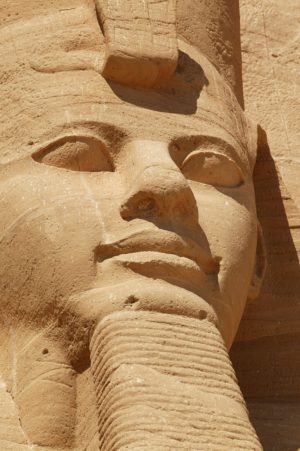 What is Ramses II’s relevance to us today, when authoritarianism appears to be on the rise and distrust that democracy can truly solve the most pressing problems of our time at an all-time high? Are we at long last beginning to walk away from patriarchy in search of more equitable systems of governance, or will things stay the same as they have for thousands of years? (Image left, Ramses statue detail at Abu Simbel, Pixabay, Public Domain)
What is Ramses II’s relevance to us today, when authoritarianism appears to be on the rise and distrust that democracy can truly solve the most pressing problems of our time at an all-time high? Are we at long last beginning to walk away from patriarchy in search of more equitable systems of governance, or will things stay the same as they have for thousands of years? (Image left, Ramses statue detail at Abu Simbel, Pixabay, Public Domain)
Is our press and media truly independent and free or is it an extension of the state promoting sanctioned propaganda?
A mark of a successful pharaoh was the ability to keep both regions, upper and lower Egypt, united and under their control. How would Ramses deal with the extreme polarized state of our country today and unify our country under one common ideal?
Increasing global income inequality is still a problem today as it was in ancient times. How did Ramses throttle or appease the priesthood and elites of his time? How would he have handled tax dodging, billionaire space cowboys of today to maintain order?
Plagues and droughts were a challenge for the Egyptians and no less of a challenge for governments of the world today.
Professor and Egyptologist Dr. Kara Cooney posits that Ramses II was a populist leader attempting to prove a point to the elites in the Nile Valley at Thebes that may have viewed him as a foreigner since he was of non-royal blood. His family hailed from the Nile Delta region in the North.
Dr. Zahi Hawass, archaeologist and former Egyptian Minister of State for Antiquities Affairs, disagrees, presenting a simpler explanation. He maintains it was because of his upbringing. Ramses was prepared by his father Seti I to restore Egypt’s glory.
Let us dig deeper into the life of Ramses II, arguably the most revered Egyptian pharaoh of all time, to gain a greater understanding of the man behind the monumental legacy he left behind:
How He Was Raised
Ramses II started his life with good fortune in the royal court—born during one of Egypt’s golden ages. His father was beloved King Seti I and his grandfather Ramses I. Seti I mentored Ramses II as did his father Ramses I. By all accounts, Seti I and Ramses II had a close and loving relationship and Ramses’ greatness was in large part due to his father’s faith and support of him early on. The two were inextricably linked.
As a young crown prince, Ramses is seen repeatedly at his father’s side in an official capacity and served as his deputy in military campaigns as well as in administrative and religious affairs. Later, as a young king, Ramses served as head of the Egyptian army, leading his campaigns in person.
He was also surrounded by accomplished government officials and high priests as a young man. One of Ramses II’s best friends during childhood was Amenemone, a royal scribe who was son of another high priest of Amun named Parennefer, who also served as Chief of Works in the Ramesseum (Ramses’ funerary temple), after the prince became king. It was during that time that Ramses was instilled with the moral ethos of ma’at – truth, justice, balance and harmony, which proved to be a guiding principle as he worked to bring a new sense of order to Egypt and her people. He was spiritually and morally prepared for the role of leader.
When his father Seti I died, we know that he went to great lengths to honor his father and carry on the values instilled in him to respect his ancestors. In the great funerary temple of Seti I at Abydos, where Ramses II restored and completed his father’s temple, he ordered an inscription called the “Great Dedicatory Inscription”, as well as on a stela from Kubban in Nubia. Both provide evidence of Seti’s love for his son and for his lifetime wish to see him rise to king. The Abydos inscription also intimately details how Seti wept at the sight of seeing his son Ramses II crowned.
Ramses’ mother, Queen Tuya, was a positive influence on him as she was a “woman with a strong personality and no doubt a great deal of patience.” She is very visible in Ramses’ monuments, always shown at his side. We also know that she corresponded with the Hittite royal court during Ramses’ reign, providing evidence she managed state affairs at times, in his absence.
All this reinforcement and guidance in his youth allowed him to later in life become a king worthy enough to be called “the king of miracles”.
How He Ruled
As a result of Ramses’ success as a military leader and master at diplomacy, the peace he gained allowed the empire to afford his ambitious building projects across the country, as his reign was marked by a long period of prosperity.
Ramses seems to have gone further than any other pharaoh in reinforcing the importance of the gods, making him an effective religious leader. He heavily reinforced the worship of the Apis bull representing the god Ptah throughout Egypt. He moved the capital and his principal residence to Per Ramessu, a faience manufacturing site and palace created by his father Seti I. The city was divided into four quadrants and dedicated to each of four gods; Egyptian gods—Amon and Wadjet coupled with Asiatic gods—Seth and Astarte. Ever the masterful marketer of his brand, this was Ramses’ way of unifying the religions of Syria and Egypt and thereby the citizenry. While Ramses is most famous for his savvy in battle, he also found ways to unite his people as well. Per Ramessu continued to prosper as a city for over ten decades after his death.
Professor and Egyptologist Ola el-Aguizy, head archaeologist excavating Urhiya’s (Iwrkhy’s) impressive tomb near Saqqara, says that Urhiya was a foreigner of Syrian descent and army commander originally serving under his father Seti I. Ramses promoted him to Great Army General and eventually became the trusted right-hand man to the king. This reveals Ramses’ character as a ruler, by rewarding a non-Egyptian and elevating him to a level never seen for a foreigner. We also know that Urhiya’s son Yupa was elevated in status by Ramses to the role of herald of the jubilee, organizing the Sed festivals of Ramses II. Yupa’s son Hatiay was given the title ‘Overseer of Works for All the Monuments of His Majesty’.
Religious scholars have tried for years to tie the villainous pharaoh of the exodus to Ramses II. The evidence, however, does not support this. Zahi Hawass reaffirms that there is absolutely no archaeological evidence, writings or inscriptions found anywhere in Egypt to support these theories, nor is there currently any evidence of Moses having existed in Egypt.
Ramses II successfully protected the people and the Empire from foreign threats. He was, as a result of this and for other reasons, a king so loved by his people that nine of his descendants used Ramses’ name to honor him and ensure the success of their reigns. Unfortunately, Egypt didn’t have a free press and almost all citizens were illiterate. Thus it is virtually impossible to find written firsthand accounts attesting to how the people actually thought of his reign. But, if we were able to ask a farmer of his time if he felt Egypt was safe and protected under the rule of Ramses, one could argue for an emphatic “yes” as the answer. A sense of safety from external threats and economic stability are foundations for happiness in any society.
How He Built
Ramses’ building campaigns covered all of Egypt. No pharaoh in the history of Egypt built as many monuments or raised as many statues as he did, which is an incredible achievement considering Egypt is the world’s longest continuous civilization. After securing Egypt’s borders, he was able to enrich its coffers by establishing more quarries and mines.
In analyzing how he built, one can also gain an understanding of how he loved. He showed his love for his mother and wife at Abu Simbel, where a colossal statue of his mother Tuya features prominently on the façade. Ramses dedicated a chapel to her beside his mortuary temple at the Ramesseum. Additionally, he ordered a 500-year-old statue inside the Ramesseum re-carved to represent his mother, revealing he didn’t usurp statues only to glorify himself. Dying in the 23rd year of his reign, not long after the signing of the Kadesh Peace Treaty, Tuya was buried in a lavish tomb in the Valley of the Queens (QV66).
Ramses married at least four wives and is believed to have married 8 total. Two in his youth—Nefertari and Isetnofret—and two Hittite wives to concrete the peace treaty with the Hittite king. The evidence shows Nefertari was his main wife and by all accounts the love of his life. So much so, that her name cartouche is found inside Ramses’ tomb KV7 in the Valley of the Kings. This shows her importance to the king as it is, so far, the only known example of the inclusion of a queen’s name inside a royal tomb. Her tomb is considered by many to be the most lavish and beautiful tomb of all the pharaohs with its vivid, rich colors showing her being embraced by the gods.
_________________________________

Tomb of Rameses II, the entrance to the fourth corridor which descends further into the tomb towards a vestibule and the burial chamber, a barrier closes the rest of the tomb to visitors. Valley of the Kings, Egypt. Dennis Jarvis, CC BY-SA 2.0, Wikimedia Commons
_________________________________
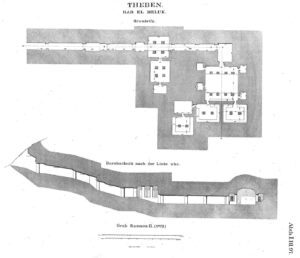
Map of KV7. Karl Richard Lepsius, Wikimedia Commons, Public Domain
_________________________________
At Abu Simbel, he built two temples, one for him and the gods and the other dedicated to the goddess Hathor and his Queen Nefertari. An inscription inside the temple reads “for whom the sun shines”. Her children are also sculpted next to her in miniature.
A master at public relations, Ramses knew how to best promote his brand. For example, he engineered the temple at Abu Simbel to align with the sunlight through the main doorway, where twice a year the divine rays of the golden sun gradually light up statues of him seated alongside the three major gods of Egypt (Ra-Horakhty, Amon, Ptah) and even designing it to leave Ptah, god of the underworld, in the shadows. It was a theatrical setting for all to imagine him just the way he wanted to be thought of—as a living embodiment of the sun god. Even today, large crowds gather twice a year on February 22nd and October 22nd to watch Ramses the Great become bathed in golden light of the sun god Ra alongside the 3 greatest gods of ancient Egypt. One solar alignment date marks the day he ascended to the throne and the other marks his birthday. Abu Simbel is evidence that Ramses was a pious man that truly loved the gods of Egypt.
_____________________________
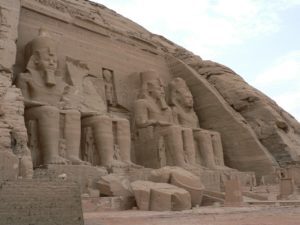
Abu Simbel. Pixabay, orsdg, Public Domain
_____________________________
In his self-divination through building, he also included his wife, Queen Nefertari. On the façade of her temple near his, there are colossal representations of her at the same height as her husband, which is unusual. Inside her temple, Ramses II is shown along the sanctuary walls offering incense to himself as a god and to Nefertari—evidence Ramses considered both he and his wife to be divine.
Finally, no other pharaoh celebrated his Queen as much as Ramses II. She accompanied him on important state events and was active in peace negotiations with the Hittites. He portrays her as his equal, a rare occurrence. She was his primary wife and co-regent until her early death, after which he ruled alone for over 40 years.
Ramses also built 4 lesser temples in Nubia. One honored the god of craftsmen, another for Nubian gods, another to Amun, Re-Horakhty and a deified Ramses II. The fourth temple served to worship Ramses II as a god alongside Amun, Re-Horakhty, and Ptah.
His son Khaemwaset continued his father’s honorable legacy. During Ramses’ reign, his son was appointed high priest of the God Ptah, patron god of Memphis and restored old kingdom pyramids, temples and tombs, already ancient in his time. These included the Dynasty I tomb at Abydos, the tomb of the last king of Dynasty 4 – Shepsekaf, the pyramid of Sahure at Abusir, the sun temple of Niuserre at Abu Ghurab, and the Step Pyramid of Djoser. He is documented as the builder of the Serapeum at Saqqara. There are bas-reliefs of him inside the Serapeum, tending the tomb of Ptah’s sacred Apis bulls. Like his father Ramses II before him, he inscribed his name stamp on older buildings that he restored, along with the original owner’s name, titles and his father’s name, as was tradition. Unfortunately, Khaemwaset died before he could become king and is considered today to be the first Egyptologist in history.
Before Ramses II was considered a god incarnate to his people, he was a human like any one of us, except he deeply believed in a social contract that was dictated by religion. This social contract meant that he would rule justly with his heart. His building projects are evidence of this belief.
He showed the love he had for his father Seti I by completing his mortuary temple at Abydos and the construction of a vast forest of decorated columns at the Great Hypostyle Hall at Karnak, also begun by his father.
Ramses built a temple at Abydos near Seti I’s mortuary temple. There is an interesting sunken causeway believed to have been built by Seti I that displays decorated scenes (Book of Gates & Book of What is in the Underworld) along its corridors that runs underground from ancient tombs of the early kings, then descends deeper to the level of the Osirion (temple to Osiris), connecting to its rear. This connecting corridor was originally covered in stone slabs but looted in antiquity and would have been a processional route that would enable worshippers to visit the tombs of early kings, then pass through the Osirion and finally ascend a stairway to enter the mortuary temple of Seti I. Both Ramses II and his father’s temples were situated as close as possible to the Osirion and the tombs of Egypt’s first kings to allow a collective worship of the first kings of Egypt, Osiris and of their own dynasty. Abydos was also considered to be the sacred domain of the god Osiris.
Ramses II showed love for his children by building a tomb for them consisting of an unparalleled 150 rooms in the Valley of the Kings, dug underground into the bedrock.
Many scholars believe Abu Simbel and the other temples Ramses built on the frontier with Nubia served several purposes: reinforce the reverence to the gods, divinize himself as a god, display his might and help secure the source of Egypt’s gold and great wealth. These temples on the hinterlands reinforced Egypt’s domain and strength in the eyes of anyone that would dare challenge her sovereignty.
Zahi Hawass offers up a simpler explanation – the temple was built to honor the king as a god and to concrete his place among Egypt’s pantheon for all eternity.
At his funerary temple at the Ramesseum where he is represented as the god Osiris, a large cache of about 10,000 papyri were discovered revealing it was a Presidential library of sorts, as well as a scribal school.
Images of Ramses were encoded to represent how he viewed himself—an agent of change, an agent to maintain order over chaos, an agent for the gods. Egyptians believed statues were magical avatars embodying the spirit of the person represented. Ramses curated his statues to represent himself for eternity and were purposely carved with his gaze looking downwards, towards his subjects. Standardized images of pharaohs in statuary look upwards towards the heavens or determinedly straight ahead, but Egyptologist Dr. Simon Connor explains that Ramses’ statuary has a unique eyeline that looks downwards. Ramses seems to have wanted to make eye contact and to connect with the people of Egypt to ultimately inspire veneration as a god. Ramses intended for the people he served and loved to intimately connect with living representations of him for all eternity.
_______________________________
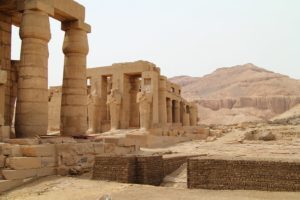
View of Ramesseum. Djehouty, CC BY-SA 4.0, Wikimedia Commons
_______________________________
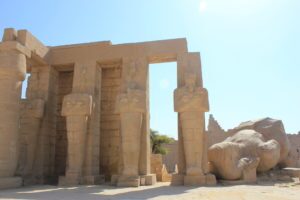
The Ramesseum Colossi at Luxor.
_______________________________
Ramses II specifically chose statues of his most prestigious forebears to rebrand and re-embody them. He purposely left evidence on the statues of former rulers, supporting the idea that he was not trying to steal their identities but instead was using the reputation of his most honored ancestors in order to spiritually increase his own power to last the ages. He was branding himself as a newer version of the leaders that came before him, ensuring he would be placed in the highest position among the pantheon of royalty. Current estimates calculate roughly one quarter of his statues were re-carved from previous ruler statues.
No other pharaoh’s imagery is as ubiquitous as his. Ramses II is literally everywhere. Today his obelisk stands center stage in the Place de la Concorde in Paris. Another obelisk stands in front of the Pantheon in Rome, taken from its originally erected site outside the temple of Re in Heliopolis. And another pair from Heliopolis of red granite obelisks are in two different places in Florence. His seated statue is the first thing you see at the entrance to the Metropolitan Museum in New York City and his 36-foot-tall colossal statue will be holding court at the main entrance to the new billion dollar GEM museum in Cairo, greeting visitors from around the world when it opens late 2022.
________________________________
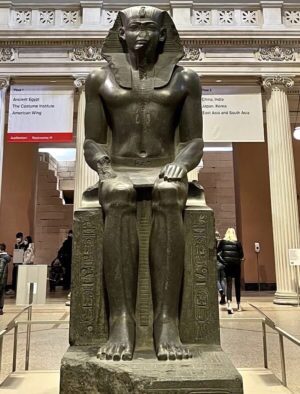
Above and below: A grand statue of Ramses II graces the halls of the Metropolitan Museum of Art in New York. Photo by Eric Vasallo
________________________________
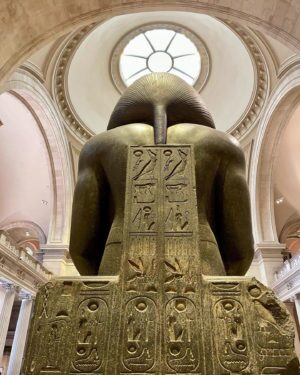
________________________________
Zahi clarifies further that this usurpation of statuary is more a result of tradition than of narcissism. Since the Old Kingdom, it was the sole responsibility of each pharaoh to supervise the burial of his predecessor and to complete their unfinished monuments. In some cases, Ramses actually re-carved statues of the hated Hyksos kings that ruled Egypt during the 17th dynasty who had usurped them from earlier Egyptian kings. It was more of a case of restoration to Egypt than usurpation for vainglorious pursuits. Additionally, Ramses added his name to monuments that were damaged or unfinished. He was either obsessed with being loved by all or saving Egypt…or quite possibly both.
How He Fought
It’s difficult to tease the truth out from what has survived the ravages of time, which are primarily state-sanctioned narratives. Still, to this day Ramses II is revered for his bravery and as an effective military commander that not only secured Egypt’s borders but expanded them. He successfully quashed a Libyan uprising, suppressed Galilee (between Lebanon and Israel) and ended the conflict with the Hittites through a combination of battle and diplomacy.
Ramses II ascended the throne at the very early age of 14 and after only his second year on the throne was challenged by a band of sea pirates called the Sherden that were plundering Egyptian vessels along the Mediterranean coast. Ramses skillfully set a trap for them using a decoy Egyptian boat and it worked just as planned. They were surrounded by Egyptian boats and in one fell swoop, defeated the pirates once and for all.
The Hittites also saw an opportunity to test the young leader at his empire’s northern border. They invaded and took over the important trading town of Kadesh in modern-day Syria. Ramses II led his forces to recapture the fortress. Evidence of his strategic genius and early divination as leader are seen in two different accounts of this pivotal and brutal battle where even the Hittite king’s brother was killed in the battle. Estimates calculate that there were about 6,000 chariots in that battle. Although the temple walls throughout Egypt show Ramses as the victor of that battle, most believe today it was a stalemate. Nonetheless, he had faced death at the Battle of Kadesh but was able to save himself and his army through his own skill and bravery. Even then, he gave credit for his survival not to his own ability but to his beloved god, Amun. Record of the battle is found in the “Bulletin” or “Poem of Pentawer-it” (named after the scribe who copied the hieratic copy in Papyrus Sallier III from tombs in Saqqara). Pentawer-it was also Ramses II’s son and successor. There are similar accounts of this battle that also appear inscribed on the walls of the temples at Karnak, Luxor, Abu Simbel and the Ramesseum. The Bulletin relates “that at sight of the approaching Hittites, the king donned his weapons and armor, leaping into his chariot with his great horses, named Victory in Thebes and Mut is Satisfied, in the yoke. Calling upon Amun for strength, he charged alone into the midst of the enemy, slaying them in their multitudes with no help from anyone.” The Bulletin gives a vivid description of the king, his eyes “savage” and his breath, fiery with rage, burning everything around him. Egyptologist, Dr. Christopher Naunton, shares a second account that reveals, at the most tragic moment, when all seemed lost in battle, his soldiers saw Ramses rise, comparing him to the great God Seth, to whom his father Seti I was consecrated:
“Thereupon the forces of the Foe from Khatti surrounded the followers of his majesty who were by his side. When his majesty caught sight of them, he rose quickly, enraged at them like his father Mont. Taking up weapons and donning his armor he was like Seth in the moment of his power. He mounted ‘Victory-in-Thebes,’ his great horse, and started out quickly alone by himself. His majesty was mighty, his heart stout, one could not stand before him.”
“In his encounter with the Hittites at Kadesh early on in the 5th year of his reign,” says Naunton, “Ramesses found himself alone and surrounded by his enemy but fought his way out to return to the Egyptian troops. He describes himself as being like the god Seth in this – as if evoking the qualities of chaos and violence that the god embodied. What’s interesting is that, whether or not you believe Ramses’ propaganda, it is telling that he wanted to depict himself as being personally involved in the battle. He wanted people to really believe he was the mighty warrior, perhaps more than other pharaohs had.”
At this battle, Ramses named his military units or divisions each with both chariots and infantry after the four gods – Ra, Amun (led by Ramses), Ptah and Seth. Ramses wanted the gods to be with his men, protecting their every step.
Ultimately, the Battle of Kadesh wasn’t a loss for Egypt and as a result, 17 years later, Ramses ended the contentious and costly conflict between the Hittites and Egypt, even going so far as to marry two of the king’s daughters to further seal a time of alliance and peace that lasted almost a century.
The two leaders forged the first treaty in history, forming the basis for future treaties around the world. A replica of that treaty carved in stone was given to the United Nations by the President of Turkey in 1970 after it was discovered in Anatolia. It is displayed today at the headquarters in New York City to remind its member nations of the importance of diplomacy and cooperation between nations.
_____________________________

Kadesh treaty replica at the UN headquarters. Credit – UN photo/R Grunbaum
_____________________________
At the siege of Daipur in Syria. Ramses fought alongside six of his sons. In reliefs at the Ramesseum, Daipur is depicted as a heavily fortified hilltop settlement with inner and outer walls. Inscriptions show chariots and ladders supported by archers and his six sons are shown wearing the youthful side-locks of royalty. References to his sons are also inscribed on the walls at the Ramesseum:
King’s son, of his body, his beloved, Khaemweset.
King’s son, of his body, his beloved, Montu.
King’s son, of his body, his beloved, Meriamon.
King’s son, of his body, his beloved, Amenemuya.
King’s son, of his body, his beloved, Seti.
King’s son, of his body, his beloved, Setepenre.
How He Celebrated
After 30 years on the throne, as was tradition, Ramses hosted a lavish (and very costly) Heb Sed festival. He held 14 festivals thereafter of no less than 10 days each, more festivals than any other pharaoh, celebrating his kingship and renewing his strength among his people. The Heb Sed was an important ritual that additionally satisfied the priest class, representing a reenactment of the unification of Egypt by Menes, founder of the First Dynasty.
Egyptian archaeologist Fathi Yaseen, while digging in Asasif mountain in Luxor, discovered why a tomb of one of Ramses II’s nobles was built so low and accessible instead of high and out of reach, as was usual. He found that it was so his family would be worshipped and visited with offerings during the Beautiful Festival of the Valley held every year. Fathi finally concluded that Ramses was a generous king, sharing the wealth of his empire with others in the kingdom in the festival every year after the first harvest. The annual festival celebrated the three main gods at Karnak Temple and their dead ancestors, where the people of Egypt would ritually bring offerings of food and drink, eating beside their tombs and ensuring their spirits had enough to eat for eternity.
How He Died
His mummy measured about 5 feet 7 inches (above average height). He was most likely red-haired and had vitiligo of the skin. A CT scan and a DNA analysis was performed on his mummy by Zahi Hawass in 2007 and it revealed he had a hardening of the arteries, arthritis and a severe abscess in his teeth. Any of these or all would have contributed to his death at age 90, which was due to natural causes. Despite his health issues, he lived an unusually long life, especially since the average age of Egyptian men at the time was about 34.
_________________________________

Details of mummy of the pharaoh Ramesses II. Cairo Museum. G. Elliot Smith, Wikimedia Commons, Public Domain
_________________________________

Ramses Mummy (Credit: Official catalog for Ramses II exhibit)
_________________________________
Though the remains of Ramses II himself has passed on into history, his legacy still lives on in the minds of millions, and his mark on Egypt still reverberates to this day.
_________________________________
Article Supplement

The following is an interview with the renowned archaeologist Dr. Zahi Hawass, who is currently curating the Ramses II exhibit at the Houston Museum of Natural Science
Q: Why was Ramses so exceptional? Why did he excel in so many fields?
Zahi: “Seti I set him up for greatness. He sent him to Heliopolis to learn the Egyptian religion and to supervise the initial construction of his father’s tomb. He wanted his name to be remembered. In my excavation south of the third pyramid of Menkaure at Giza, I recently discovered a large double statue of Ramses II with the Sun God Re. Also, near Abu Sir, we found the remains of another temple for him. We have a statue here in the exhibit from the Middle Kingdom that he took for himself. He didn’t do it for himself, he did it to renew and restore the image of the people before him. Many statues have his name carved beside the previous owner’s name. He was a family man. He had at least 8 wives, but Nefertari was his one and only. He was a very romantic man, a military man, a builder, a religious man because he restored the images of every god. He built one of the most beautiful tombs for Nefertari and another temple next to his at Abu Simbel with her children next to her. Ramses was the only king that built a temple for his queen. The only one. [This] never happened in the history of Egypt at all. At Abu Simbel he inserted himself beside three other gods to receive the light of the sun twice a year. I believe he built Abu Simbel to give offerings to the gods. He worshipped himself as a god. When he lost that battle at Kadesh, I believe he was afraid he would never be a god and therefore he built this temple as a god worshipping himself.”
Q: Are there any other recent discoveries of Ramses II?
Zahi: “There is a scene inside Ramses II’s tomb that has been recently cleaned which provides insight on how he ruled. An incredible discovery. The inscription is of hour number five from the Book of the Gates, which refers to the “others”, referring to other countries or peoples. It shows the Sun God Re in his royal boat. In front of him are four Egyptians standing, in front of them four Nubians, four Libyans and four Mesopotamians—all standing and unbound. It is interpreted to be a statement of the Sun God to say that he created all people and that all will be able to go to paradise. A rare and inclusive message.”
“In yet another instance of Ramses II following in his father’s footsteps, this same inscription was also found inside Seti I’s tomb.”
Zahi shared how he supervised a recent excavation underneath the construction of a supermarket in Cairo’s al-Matareya neighborhood, where three important temples were discovered—one for Ramses II, another for Akhenaten, and lastly, Thutmoses III.
Q: What is your favorite artifact at this exhibit?
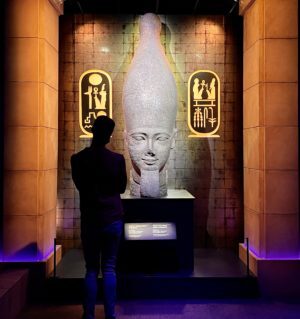 Zahi: (eyes light up) “Oh, I have to tell you that when I wrote the catalog and two additional books for this exhibit—one souvenir book, one exhibit catalog and one book for children—at first, I was doubtful of this exhibit’s impact. But seeing all these beautiful artifacts all together in the space and the way the exhibit highlights each object so well, I have to tell you that every single object in this exhibit captured my heart. Each object is incredible and will capture the heart of every visitor. They will tell many wonderful stories of ancient Egypt. The collection will teach the people about Ramses as a builder who built temples everywhere from Abu Simbel in the south up to Alexandria in the north. At the same they will look at him as a warrior but also a peacemaker after what I believe was a loss at the battle of Kadesh. He won several other battles against the Hittites but he was ultimately a peacemaker because after that battle, the two countries signed a peace treaty. Ramses also agreed to marry two of the Hittite king’s daughters to finalize the agreement. One wife was very sick. We do not know what sickness she had. It is documented that she needed help because she visited the temples of Sekhmet the goddess of healing at Karnak and Abusir near the pyramids. Some people believe it was the plague. We still aren’t sure. We do know that in Amarna there was a problem with malaria. Through CT scanning we determined that King Tutankhamen died of malaria.”
Zahi: (eyes light up) “Oh, I have to tell you that when I wrote the catalog and two additional books for this exhibit—one souvenir book, one exhibit catalog and one book for children—at first, I was doubtful of this exhibit’s impact. But seeing all these beautiful artifacts all together in the space and the way the exhibit highlights each object so well, I have to tell you that every single object in this exhibit captured my heart. Each object is incredible and will capture the heart of every visitor. They will tell many wonderful stories of ancient Egypt. The collection will teach the people about Ramses as a builder who built temples everywhere from Abu Simbel in the south up to Alexandria in the north. At the same they will look at him as a warrior but also a peacemaker after what I believe was a loss at the battle of Kadesh. He won several other battles against the Hittites but he was ultimately a peacemaker because after that battle, the two countries signed a peace treaty. Ramses also agreed to marry two of the Hittite king’s daughters to finalize the agreement. One wife was very sick. We do not know what sickness she had. It is documented that she needed help because she visited the temples of Sekhmet the goddess of healing at Karnak and Abusir near the pyramids. Some people believe it was the plague. We still aren’t sure. We do know that in Amarna there was a problem with malaria. Through CT scanning we determined that King Tutankhamen died of malaria.”
Certainly, we haven’t heard the last from Ramses the Great. At our meeting in Houston for the grand opening of the Ramses II exhibit and their new Egyptian Hall, Zahi shared an exclusive discovery from an all-Egyptian re-excavation of Ramses II’s tomb (KV7) that he is supervising in the Valley of the Kings. The tomb was heavily damaged from flooding, and they have thus far removed 60,000 square feet of rubble. It is two times the size of his father’s (Seti I) tomb –over 300 feet long. They have cleared and cleaned many scenes of the Book of the Dead and recently discovered an unusual shaft in his tomb. Usually, shafts are carved out of the stone to foil thieves by trapping them or as a flood relieving device. This shaft is very unique because they are usually bare and unfinished. This shaft’s walls are decorated at about 200 feet down. There are scenes of the Birth of the Sun God Re.
Ramses’ tomb has been excavated many times during history, but never fully excavated, so there may yet still be treasures to uncover inside. The newly discovered shaft is the only example of a tomb well-shaft in the Valley of the Kings that is fully decorated with painted scenes.
Zahi hopes that Ramses may have built this shaft to secret away his royal furnishings in the same way that his father’s tomb featured an unfinished vertical shaft extending down into the Earth over 173 meters. He also believes that, in his words, “it might hold a tunnel that connects his tomb with the adjacent KV5 tomb, which was built for his children.”
One can only imagine what will be discovered inside this shaft to tell us more about this iconic figure’s life. After all, the greatest treasure is information.
________________________________
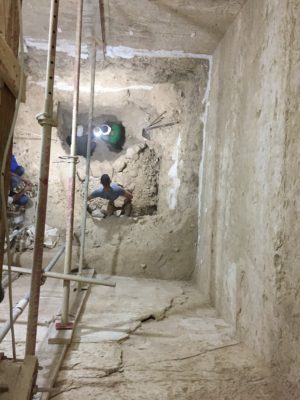
Above and below: Views of excavation work on the KV7 shaft.
________________________________
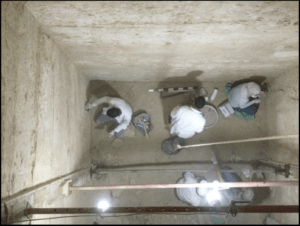
________________________________
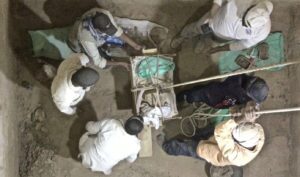
________________________________
Readers can get ‘up close and personal’ to the man that became king, that became a god, at the Houston Museum of Natural Science. The showing lasts until May 2022 before proceeding to San Francisco and a six-year, 10-city world tour.
This major exhibit on Ramses II’s life and the gold of the pharaohs coincides with the reopening of the new Egyptian Hall in the Houston Museum of Natural Science. It is a beautiful and important exhibit curated by Thomas Hardwick and one of the most complete collections of Egyptian artifacts outside of Cairo. The exhibit also features a remarkable golden room full of beautiful scenes from the Book of the Dead, inspired by King Tutankhamun’s golden funerary shrine.
In the state-of-the-art Ramses II exhibit, visitors can walk among real colossal statues and witness a multimedia re-creation of Ramses’ triumph at the Battle of Kadesh, widely considered the largest chariot battle ever fought in the history of the world. There is also a powerful and immersive virtual reality experience by Positron, transporting visitors to Egypt’s golden age with fast-paced highlights of the pharaoh’s greatest moments, the temples of Abu Simbel, and Nefertari’s Tomb. It is narrated by a ghostly apparition of Nefertari, who attempts to rejoin her husband in the afterlife.
The much anticipated, spectacular billion-dollar GEM museum is also slated to open sometime in November of 2022 (TBD), which will be among the largest and most important museums in the world, showcasing thousands of artifacts never before seen by the public. It is designed to architecturally complement and align with the great pyramid of Giza nearby – one of the original seven wonders of the world.
________________________________
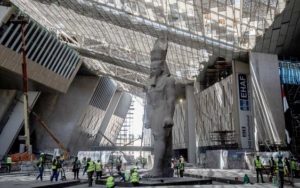
The GEM entrance. Khaled Desouki/Getty Images
____________________________________
Egyptians believe words, like symbols, had magic and power, and that if you say a person’s name repeatedly, they will live forever.
Article Supplement cover image above: Dezalb, Pixabay
________________________________
Sources:
Ozymandias by P.B. Shelley – https://www.poetryfoundation.org/poems/46565/ozymandias
Houston Museum of Natural Science – Ramses II Exhibit until May 2022 https://www.hmns.org
Dr Chris Naunton, Egyptologist www.chrisnaunton.com – Ancient Egyptian Literature, Volume II: 2 (p. 105). University of California Press. Kindle Edition which is available here: https://www.amazon.co.uk/gp/product/B00720JSQI/ref=as_li_tl?ie=UTF8&camp=1634&creative=6738&creativeASIN=B00720JSQI&linkCode=as2&tag=chrisnaunton-21&linkId=5430e9922f21ef33f61b53121e731f84
Zahi Hawass – His latest books on Ramses II written for the Houston Museum of Natural Science – Ramses the Great and the Gold of the Pharaohs (official catalog) Laboratoriorosso, 2021. Books can only be purchased at the museum. Buy tickets for the Ramses II exhibit here – https://www.hmns.org/exhibits/special-exhibitions/ramses-the-great-and-the-gold-of-the-pharaohs
Kara Cooney joins UCLA Fowler Museum to discuss her latest book, on Off the Press: “The Good Kings” https://fowler.ucla.edu/video/
Kara Cooney discusses Ramses II in this podcast –True Crime: Ancient Egypt Edition – https://podcasts.apple.com/us/podcast/afterlives-with-kara-cooney/id1585193255?i=1000539630324
Kara Cooney’s latest book – The Good Kings – get signed copies here – https://www.booksoup.com/book/9781426221965
Ramses Rise to Power: Lost Treasures of Egypt – Episode 3, Season 3
https://m.imdb.com/title/tt15433480/?ref_=tt_ep_pr
Egyptologist Simon Connor – https://independentresearcher.academia.edu/SimonConnor/Papers
Per Ramessu – https://www.britannica.com/place/Per-Ramessu
Video reconstruction of Ramses II capital city – Per Ramessu – https://vimeo.com/194362703
A Layman’s Guide to the Osireion https://www.academia.edu/37568156/The_Osireion_A_Laymans_Guide
Battle of Kadesh – Poem of Pentawerit – https://ancientegyptonline.co.uk/battle-kadesh/
Siege of Daipur inscriptions at the Ramesseum-
Kitchen, Kenneth A (1998-12-17). Ramesside Inscriptions. Wiley-Blackwell. p. 83. ISBN 978-0-631-18435-5
Treaty of Kadesh replica at the United Nations –
https://www.unmultimedia.org/s/photo/detail/111/0111527.html
Heb Sed Festival
https://www.arabworldbooks.com/en/e-zine/the-sed-festival-heb-sed-renewal-of-the-kings-reign
_________________________________
Advertisement




